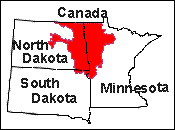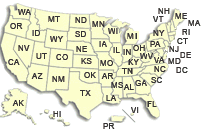Minnesota Water Science Center

RedN NAWQAUSGS IN YOUR STATEUSGS Water Science Centers are located in each state. 
|
National Water-Quality Assessment Program
AbstractAtrazine was the most frequently detected pesticide at each stream site. The southern part of the Red River Basin, where corn is most widely grown, has a greater amount of atrazine use per land area than any of the three subbasins sampled (all of which are in the northern half of the Red River Basin). However, 1993 data indicate that the Wild Rice River Basin, where, based on corn acreage, atrazine application is low, had the greatest atrazine yield. Factors other than application rates, such as chemical degradation and intensity and timing of runoff, also affect the amount of atrazine reaching stream-basin outflows.
Table 1. Estimated atrazine usage and stream loads for 1992 in the Red River
ofthe North drainage basin.
----------------------------------------------------------------------------
Site name Drainage area, Atrazine Atrazine load,
in square usage, in in kilograms
kilometers kilograms(a)
----------------------------------------------------------------------------
Wild Rice River at Twin 2,407 1,250 22
Valley, Minn.
Turtle River near Larimore, 806 780 .37
N. Dak.
Snake River at Alvarado, 566 240 1.3
Minn.
Red River at Emerson, 90,600 115,000 610
Manitoba
----------------------------------------------------------------------------
|